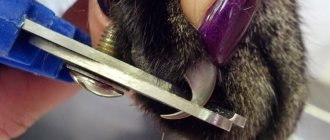5830Administration
A newborn kitten is always a joy for all inhabitants of an apartment or house. You need to prepare for it in advance. Despite the fact that a cat knows at the genetic level how to survive in nature, it is not always able to survive this process on its own. Therefore, every cat owner should know what to do if the cat cannot give birth.
There are cases when, if help was not provided, a pet began to die from various complications. This usually affects artificially bred breeds that have undergone changes at the genetic level and cannot reproduce normally. Therefore, they are not able to cope with what ordinary yard animals can easily cope with.
© shutterstock
How does childbirth occur in cats?
Cats bear offspring for approximately 2.5 months. During one birth, 1-2 kittens are born, as well as 6-7. The process itself takes several hours and consists of several stages. If you are helping your cat give birth, then you need to know how everything usually goes:
- pushing – kittens pass through the birth canal in 4-5 pushing;
- birth - kittens come out in the amniotic sac, less often without it;
- starting breathing - the cat breaks the bubble and licks the born kitten, removing mucus from the respiratory tract;
- rupture of the umbilical cord, eating the placenta - after the kittens, an afterbirth (placenta) comes out, which the cat eats. As many babies are born, so many placens should come out.
Human assistance may be required at each stage of the birth of kittens. When all the babies have come out, all the amniotic sacs have been ruptured, the cat has licked all the babies and they are suckling milk - everything is done. Further assistance will be reduced to proper care of the newborn pet.
To know for sure that all the kittens have come out, it is advisable to first do an ultrasound and count the fetuses. Then there will be no cause for concern if the number of babies born coincides with the number given by the veterinarian.
Help with normal childbirth
Childbirth is a very intimate process, so the owner must provide his pet with a calm environment. If childbirth proceeds normally, then any active intervention is not recommended; nature itself will do its job.
In case of slow labor, after the fetus has already appeared in the birth canal, you can slightly speed up its progress:
wait for contractions and pushing (their onset can be understood by the characteristic contractions of the abdomen); slowly and carefully pull out the kitten, carefully grasping it with your fingers through a napkin; alternately, just a little, rotate the kitten left and right.
Correct care for a woman in labor
In the wild, cats give birth on their own, but in domestic cats, their natural instincts are muted. For this reason, it is desirable that the owner be nearby during childbirth and can provide the necessary assistance in a timely manner. It is especially needed for a cat giving birth for the first time. The pet can only guess what will be required of her. The owner’s task is to act competently and, if necessary, call a veterinarian.
Correct actions with the amniotic sac
If the bubble with the kitten inside is not damaged, if the fetus lies correctly head first, then your help will not be required. You need to intervene in the following cases: - if the bubble is torn, prepare a clean cloth, wrap it around the kitten and gently pull at the next contraction; - if the bladder is torn and the kitten is walking butt, pull without waiting for a contraction, speed is more important so that the baby does not suffocate.
If the cat does not chew the amniotic sac, this must be done for her. You will need sterile scissors. Act quickly - if you wait more than half a minute, the kitten may suffocate.
If the kittens are too big
It is difficult for a cat to give birth to large babies. It will also be difficult for you to remove the kitten; it will slip back into the vagina. If your cat's vulva is dry, lubricate it with Vaseline or lubricant. Proceed as follows: - wait for the next contraction when the baby approaches the vulva; - insert the index finger of a sterile-gloved hand into the vulva a few centimeters and move the skin towards the anus; - as soon as the kitten appears, grab it and move it slightly to help it come out. Determine the intensity of the impact yourself individually.
What to do if a kitten gets stuck
A few hours before birth, kittens take a forward-facing position. But sometimes babies change position or their head is turned to the side, making it difficult to exit the vulva. To help a stuck kitten be born, lubricate the vulva with lubricant or Vaseline and with a sterile gloved hand perform the following manipulations: - carefully insert your finger into the baby’s mouth, if the amniotic sac allows it; — turn the kitten’s head in the right direction so that the cat’s contractions push it further; - press on the cat's perineum at the bottom of the anus - this will cause a contraction, and the baby will not be able to return back.
We do the same if the kitten moves forward with its sacrum - grab it by the paws and guide it along the birth canal.
It happens that for some reason kittens die in the womb. In this case, they will still be born naturally. The cat will go into labor, and if your help is needed, you can act less carefully. It is important that everything is in order with the cat, so if the fetus is stuck, feel free to pull on any part of the body.
Signs of approaching labor
Signs of impending labor in cats can appear either the day before birth or one to two hours before it. It depends on the characteristics of each cat’s body. In cats giving birth for the first time, symptoms begin earlier because the animal’s body takes more time to adjust.
Signs of imminent labor are as follows:
- The animal loses its appetite, it drinks a lot - this is how the body prepares for lambing ;
- Manifestation of lethargy - the cat spends almost all of its time in the place that it has chosen for birth;
- The active movement of the abdomen is noticeable, since the kittens move energetically before the onset of contractions, taking the most convenient position for passing the birth canal. If there are many kittens or they are large, then such a movement can begin two days before birth;
- The cat actively licks the genital slit, because... vaginal discharge appears. She maintains cleanliness as this is important to prevent infection;
- The removal of a plug that covered the uterus during pregnancy. If the plug comes out, labor will begin within one to two hours;
- Rectal temperature drops to 37 degrees (this prevents bleeding after childbirth and during the process);
- The appearance of colostrum - when you press on the nipples, a white drop appears;
- The cat hunches over, screams and tries to hide - this behavior is possible 4-6 hours before the onset of labor due to the appearance of false contractions. They prepare the appearance of kittens, but do not open the uterus. False contractions help determine the appearance of real contractions.
What not to do during childbirth
In the desire to help a giving birth cat, it is important not to harm. There are a number of actions that are prohibited. What you shouldn't do:
- do not press on the stomach, this will cause pain to the cat and harm the kittens inside;
- do not pull the umbilical cord so that it does not break or cause a hernia in the cat;
- do not burst the bladder if the woman in labor is ready to do it herself;
- Do not give injections without your veterinarian's approval and do not use medications to induce normal labor.
- do not use instruments without sterilization to avoid infection;
- Do not take kittens away from your cat immediately after birth.
Causes of problems
Taking a dip at home is quite easy. It doesn’t matter if it’s a village house or a city apartment. But in some cases, the pregnancy period has passed, and the cat still does not give birth, although all the signs are obvious. The kittens will continue to grow, taking away strength and energy. The larger the fetus, the more difficult the birth will be. They should not be tightened.
Let's list the main reasons why a cat is unable to go into labor on time:
- malposition;
- the kitten is too big;
- narrow pelvis;
- insufficient amount of lubricant;
- incomplete dilatation of the cervix;
- age of the cat;
- mechanical injury;
- inflammation of the genital organs;
- the cat is overweight;
- breed characteristics - dwarf, Himalayan;
- anatomical properties of the vaginal vault.
Weak labor activity stands out. There are two main types. The first is a slight tone of the uterus. It is caused by a lack of the hormone oxytocin. In rare cases, calcium. The second occurs when labor lasts more than a day, the cat has lost a lot of strength and can no longer push.
To avoid the problems described above, a pregnant cat is taken to a veterinarian before giving birth. He conducts examinations and makes recommendations if any of the listed anomalies are detected. In rare cases, hospital observation is required to prevent the death of a cat and its offspring. This could be a clinic in Moscow or a good provincial one.
Possible complications
Lambing does not always go well. Possible complications during childbirth in cats can be caused by a variety of reasons. Some difficulties can be dealt with on your own, but most problems that arise require urgent intervention from a veterinarian.
You should call your doctor immediately if one of the following situations occurs:
- the duration of pushing exceeds 1 hour, and the kittens have not begun to be born;
- the animal has become weak, apathetic, lies motionless or constantly meows, experiencing severe pain;
- the number of placentas is less than the number of newborns;
- clear blood discharge appeared;
- body temperature differs significantly from normal in one direction or another;
- contractions are sluggish and rarely repeat (with an interval of 30 minutes or more);
- The amniotic sac burst and the kitten got stuck in the birth canal.
Most of these signs are symptoms of uterine dystonia or atony, which requires urgent veterinary attention, often including a cesarean section. Any delay can be fatal for the cat and cubs. But in simpler situations, you can help the woman in labor yourself.
Stuck kitten
In such cases, the clinic resorts to caesarean section. To help yourself, you should rub your stomach in time with your pushing. It is absolutely forbidden to pull a newborn by the head, otherwise you can simply break the neck. You need to pull the baby by the skin or by the body. The movement should not be directed perpendicular to the animal’s body, but from side to side.
Premature birth
To determine the lambing date, it is necessary to take into account the breed of the animal and some subjective factors. In outbred cats, premature birth usually occurs without negative consequences for the mother and newborn babies. A purebred cat can not only lose kittens, but also die itself.
In order not to miss this moment, you need to constantly monitor the condition of the pregnant pet, taking into account that there is a high probability of intensive onset of labor. You can save a cat in such a situation with the help of special medications that reduce stress, and then contact a veterinarian.
Weakness/absence of contractions
The reasons for weakness or absence of contractions are usually due to poor nutrition and a lack of certain substances in the body (calcium, oxytocin). To eliminate the problem, oxytocin preparations or the administration of a calcium borogluconate solution are used. But inducing labor this way is too risky because it can cause uterine rupture. Therefore, in most cases, a caesarean section is performed, but also solely based on the feasibility of such an operation.
In itself, a caesarean section does not pose a threat to the life of the animal; it is performed under general anesthesia and allows you to save both the woman in labor and all her offspring. Some complications are possible only in the case of serious pathologies in the development of the placenta or intrauterine decomposition of the deceased fetus. In such situations, there is a high probability of complete removal of the uterus, which will make the cat infertile, but will help save her life.
Preparing for lambing
As the moment of delivery approaches, the cat changes its behavior:
- becomes restless;
- constantly licks the belly and the area under the tail;
- looking for a secluded place, trying to climb into the closet and arrange a bed.
Such changes begin about a week before lambing. Having noticed them, you need to make adjustments to the diet, reducing portion sizes and increasing the number of feedings. This is due to the fact that the kittens inside do not allow the stomach to stretch to its usual size.
The second step is to visit the veterinarian for a prenatal examination and obtain the necessary advice. Also, for a long-haired cat, the doctor can trim the hair near the tail and around the nipples, but this is also not difficult to do yourself.
If any deviations from the normal course of pregnancy are noted, it is better to have a specialist deliver the cat. If your pet is in good condition, you can accompany this process yourself.
Another preparatory moment is arranging a place for the future woman in labor. To do this, there is no need to purchase anything extra, since the animal will prefer a secluded place to any special bed. Therefore, it is recommended to take a regular but suitable-sized (quite spacious) box with a lid, cut a hole in the side and place a clean rag on the bottom. It is advisable to place it in a separate room where people rarely enter. Bowls for food and drink are located nearby, and a little further away there is a litter tray.











